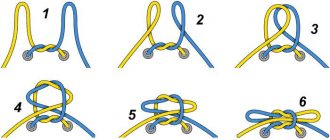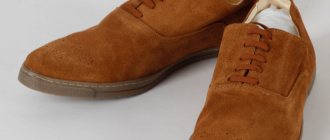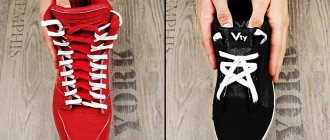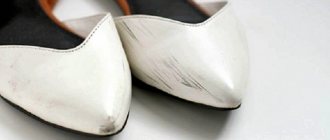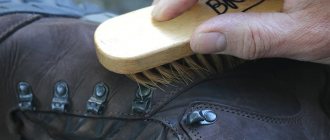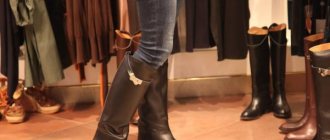With the help of seemingly insignificant details, you can create competent accents in the image. If a man takes a responsible approach to his appearance and the condition of his shoes, he will probably be interested in how to beautifully tie the laces on classic, sports and seasonal shoes. And the stylists, in turn, offer several interesting ideas on how to lace up shoes, sneakers or sneakers.
For many modern men, the factory version of weaving laces with a butterfly has already become something boring and ordinary. Another thing is new and creative options, thanks to which you can distinguish yourself with exquisite taste and originality. This question is especially relevant now, when men have at their disposal multi-colored laces from all kinds of fabrics, which are selected to match the overall style and image.
How to tie shoelaces beautifully, depending on the shoes
When choosing methods and techniques for weaving laces on shoes, stylists advise paying attention to such indicators as the style of the shoes themselves and the general image of the man. For example, those techniques that will look ridiculous and inappropriate on classic shoes are suitable for sports shoes. And for demi-season and winter boots, experts have selected separate methods.
On boots
The first shoe to consider in the context of lace weaving is boots. When choosing a lacing option, a man needs to take into account, first of all, the general style and design of the shoes; if the shoes are closer to the classics, it is worth choosing more traditional techniques; for shoes close to the sports style, creative and bold lacing is allowed.
Most often, stylists advise trying several lacing options for boots:
- Diagonal - this way you can lace so that the laces do not come undone throughout the day. An additional bonus will be the original diagonal pattern that is obtained from the lace. Stylists advise to weave both laces the same way on formal shoes, and on casual and sports shoes to make a mirror image of the weaves.
- The traditional method - in this case, it involves lacing the shoes in a zigzag manner, starting from the bottom holes, crossing the ends of the lace with each other, ending the process to the last holes.
- Straight lacing looks very strict and presentable on winter boots of both classic and free style. Its peculiarity lies in the hidden lacing, after which only straight lines of lace remain on top of the shoes.
If you plan to wear boots with lashes, experts advise using round laces, which are resistant to friction and will therefore last much longer. To keep the loops and laces firmly without kinks, it is better to use simple cross lacing. In this case, the edge of the lace is threaded into the lower loops of the shoe, after which it is distributed into two equal strips. Next, the edges are crossed, brought into the next loops higher, and so on until the very top.
On shoes
You should be especially careful when choosing ways to tie the laces on classic shoes, since in most cases these shoes require compliance with the dress code. In addition, shoes often have fewer holes than other types of men's shoes. Stylists advise considering several simple ways to tie your shoelaces, namely:
- Criss-cross is a traditional technique of weaving laces crosswise on classic shoes, but it is also allowed on other types of shoes.
- Diagonal - diagonal weaving of laces on shoes, suggesting a traditional weave of laces, but in a diagonal direction.
- Over-under is an over-under cross technique, as a result of which the lacing alternates on top or inside the top of the shoe, which is appropriate on Oxford shoes, for example.
- Straight bar is a direct method of weaving laces, which creates parallel lines of laces. At the same time, the shoes look light and attractive, but on tight-fitting shoes, it may be difficult to tighten the laces.
- Vice versa - lacing in the style of maximalism (the second name is “military lacing”), during this technique a variant of straight, diagonal and rectangular weaving is used.
- Lattice - weaving lace using the lattice method, as a result of which simple laces will look cool and original. And to learn how to tie your shoelaces using this method, you need to have shoes with 6 holes.
To look stylish and original, a man just needs to practice with the above shoe lacing options. Particular attention should be paid to the color and texture of the laces so that these criteria fit into the overall image of the man.
On sneakers and sneakers
It is not always appropriate to tie the laces with a bow if a man prefers sports shoes. Therefore, it is worth separately considering the advice of experts on how to tie the laces on sneakers and sneakers to look fashionable and original. Several lacing options are suitable for this style of shoe:
- Zigzag lacing - the laces are threaded through the bottom holes, crossing the edges, leading them to the next pair of holes above.
- Ladder - first, the wound laces are pulled out, then one edge is inserted crosswise into the top hole, and the second edge is drawn one hole higher. According to this principle, alternating lacing continues.
- External lacing - on the inside, the lace is crossed, passed through two holes, both edges are brought out and crossed again, after which they go inside and again repeat the whole principle of weaving.
- Straight lacing - one edge is drawn from the inside of the upper hole, stretching to the opposite side. Next, one hole is passed, drawing the edge of the lace higher from it, and the second end is passed according to the same principle through the missed holes.
Expert opinion
Helen Goldman
Male stylist-image maker
If the laces on shoes need to be woven according to the dress code and formal style, then in the case of sneakers a man is free to choose absolutely any lacing option. Today, mathematicians offer more than 4 million ways to tie shoelaces.
Shapes: Round and flat
For dress shoes, choose thin waxed laces. Fluffy synthetic ones, as in the picture in the middle, are only suitable for sneakers and sneakers.
First of all, pay attention to the shape of the laces. When it comes to classic shoes, it is customary to use two options: the popular round ones and the less common flat ones. The latter look more original, which is why they have recently become fashionable. Flat laces are higher in formality than round laces, so they are more suitable for business and casual shoes than for country shoes. Even if your shoes are perforated (not through them, of course, but in the brogue style), then with flat laces they will be appropriate in a business atmosphere.
How to tie your shoelaces so they don't come undone?
Experts are ready to share advice on how to tie your shoelaces without a bow and prevent them from coming undone. The most reliable way is a surgical knot, which will allow a man to forget about his shoelaces for a long time. The surgical knot is performed as follows:
- The laces are tied around the perimeter of the shoes in the usual way.
- Then a knot is made of them at the end, wrapping them behind each other.
- On the right lace you need to form a loop that will look in the direction to the left.
- Now the second edge of the lace is pulled inside this loop, another loop is formed so that its end is also directed to the left. This will allow you to make two parallel loops.
- At the end, a strong knot is tightened from these two loops, pulling the edges of the laces in different directions.
Using this principle, you get a fairly tight and clearly fixed knot, which simply won’t come undone on its own.
How to prevent unraveling
It often happens that shoelaces come undone at the most inopportune moment. Sometimes there is no time or opportunity to tie them.
In addition to the traditional bow, there are several reliable knots that can be used when tying shoelaces - then the knot will be strong and will not let you down at the most inopportune moment.
Straight knot
The simplest and one of the most reliable . Easy to tie, quickly untied by hand, even if the laces are wet, but does not unravel on its own.
How to quickly tie your shoelaces?
Another skill that is relevant today is the ability to quickly tie shoelaces to save time and effort. To get a quick knot, a man needs to perform the following manipulations:
- laces are laced according to the usual method, tightened according to the length and circumference of the leg;
- the laces are placed on the palms so that both ends point in opposite directions;
- after this, two loops should be made with the ring, middle and little fingers, after which the lace is placed on top of the thumb and index finger;
- the loops are placed on top of each other, making a turn like a sea knot;
- after which the loops on the right and left sides are tightened in directions opposite to themselves.
Can you quickly lace your shoes?
Not really
A bowtie made of lace will not always be appropriate, especially if it is long laces that will form an excessively large knot. In this case, experts advise tucking the edges of the laces into the holes of the shoes in a mirror image, and then stretch them along the entire length of the lacing from the inside.
Method 1. Criss-to-cross lacing
Every child knows the traditional way of lacing shoes Criss-to-Cross. It is simple, functional and quite versatile. If you are a practical person, this is the best choice for you. The method is time-tested and will fit any men's classic shoes.
How to tie shoelaces using the Criss-Cross method:
- The lace is passed through the bottom holes of the shoe from the inside and out on both sides. It is important that the laces are the same length at this stage.
- Take one end of the lace and pass it through the next empty opposite hole.
- Repeat the operation with the second lace. You should now have a crosshair of laces.
- Continue this simple operation to the very top holes.
Method 3. Lacing Cross over and under
As the name suggests, after lacing your boots, you will have an alternating cross ABOVE your boots and UNDER your boots. This method looks best on boots with 5 or 6 holes on each side. Quite an interesting way of lacing, especially if you have classic Oxfords.
How to tie shoelaces using the over-under cross method:
This is interesting: Where are the sandy beaches in Crimea?
The first thing you need to determine is how many crosses OVER you will get. If you have up to 4 holes, you will only get one full cross. If you have 5 or more holes, then you will get 2 or more crosses OVER the boots.
If you have 3 holes:
- Thread the lace from the inside so that both ends come out from the inside. It is important that the laces are the same length at this stage.
- Next, cross the laces and thread them through opposite holes on the outside to form a visible cross.
- Next, do the same as in the previous step, only this time you will have an invisible cross UNDER your boots.
If you have 4 holes:
- Thread the lace from the outside so that both ends go inside. It is important that the laces are the same length at this stage.
- Next, cross the laces and thread them through opposite holes on the inside to form an invisible cross.
- Next, do the same as in the previous step, only this time you will have a visible cross ABOVE the ankle boots.
- The next cross will be invisible, after lacing both ends will come out from the inside to the outside.
If you have 5 or more holes:
- Thread the lace from the inside so that both ends come out from the inside. It is important that the laces are the same length at this stage.
- Next, cross the laces and thread them through opposite holes on the outside to form a visible cross.
- Next, do the same as in the previous step, only this time you will have an invisible cross UNDER your boots.
- Repeat both previous steps and you should have 2 visible and 2 invisible crosses (if there are 5 holes).
Lacing shoes: are there any rules?
There are no strict rules when choosing a lacing method, but there is one overriding principle. If shoes are worn “out” along with a strict classic suit, then it is better to prefer traditional options . When an informal event is expected ahead, you can take a little liberties and move away from the strict image. In this case, unusual boot lacing options will come in handy.
How to lace shoes with loops
There are many ways to lace shoes with loops in a beautiful and original way. Here are some of them.
Infinity
One part of the lace must be pulled through two loops, which are located one above the other. Go to the second side.
Such actions should be done to the end and with the second part too.
Zigzag
Run one end diagonally to the last loop. And wrap the other end around each loop diagonally.
Double reverse
Pass both ends through the loops. Cross over each other and secure on the next row. Next, pass each end on the same side through two loops and cross again.
Now you've learned a lot of new ways to tie your shoes. Some of them look fashionable and unusual, while others serve to solve practical issues. Don't be afraid to experiment!
How to fold a robe without wrinkles?
What to wear with pumps
Original types of lacing
Of course, shoelaces can be tied using the usual methods, especially since we have already listed them. But there are several ways that will make your shoes, if not a work of art, then certainly greatly decorate them. Let's talk in more detail about how to beautifully tie laces on boots and other footwear. Many technologies are as simple as those described above, and the result looks stylish and unusual.
Web
Women's shoes laced this way will look very cute. But for everything to work out, you should use shoes with a wide “tongue” and choose a relatively thick lace. The shape does not matter; both flat and round options are suitable.
When everything you need is at hand, follow these steps:
- Find the second holes from the bottom and pull the end of the lace through them.
- Go back and thread it through the holes you left. Do this from top to bottom, creating vertical "stitches".
- The left end is threaded into the third hole on the right. After this, you need to wrap it around the lace that comes out of the bottom hole.
- On the right, the action is repeated.
- Insert the lace from the third hole into the fourth from the left and wrap it through the third.
- The procedure is repeated with the other tip.
The rule of success is to continue and not deviate from the pattern until the holes run out.
Butterfly
Another way to decorate shoes in an unusual way using only lacing is to tie them with a “butterfly”. But to do it correctly, you need to count how many holes there are in the shoes. If their number is even, the first “stitch” will be on the bottom, and if there is an odd number, the first “stitch” will be on top.
- When the position is chosen and the stitch is made, the ends, without crossing, are sent to another row. This is done from the reverse side.
- Next you need to cross the ends.
- Repeat the procedure until you reach the last couple of holes.
- Thread the ends through them and tie them with a bow, which will act as a butterfly.
This weaving looks very cute and unusual, although there is nothing complicated about it.
Railway
All types of shoe lacing have their own characteristics, and railway lacing is no exception. To get the desired effect, you need to follow the instructions:
- The stitch is done from bottom to top.
- The next one is vertical, sending the right tip into the right second hole, and the left tip into the left.
- Then the ends are crossed, after which, when lacing, the left lace goes to the right, and the right one to the left.
- The next step is another vertical stitch to reinsert it into the hole.
But keep in mind that railway weaving is only suitable for thin and durable laces. Thick and flat ones will not work, as they will constantly twist. They will not create the necessary tension due to the fact that they are stretched. As a result, the shoes will not be firmly fixed.
sawtooth
Tie this lacing option and see how your winter boots, even those that are already boring, will “sparkle.” Peculiarities:
- Pull the ends through so they are inside the shoe.
- Take the left tip and pull it through the third hole on the right.
- You don't need to do anything to the right end.
- The left lace is threaded through the third hole on the left.
- Then the procedure is repeated, but only on odd holes.
- The right end is threaded into all the holes that remain.
The result is a sawtooth, asymmetrical pattern. This weaving is easy to tighten, but since the tension occurs only in one direction, some side of the sneaker moves. Some manufacturing companies, when making shoes, provide for this feature, so they try to correct the effect of dragging with design.
Two-color
The main feature of this lacing is that it is fashionable and unusual. As the name implies, here you need ribbons of two colors, preferably as contrasting as possible. They are connected to each other. This needs to be done as firmly as possible so that the joint does not come apart.
True, the knot can interfere. Then you can try sewing the ends together. But again, the connection point must be secured as securely as possible. And when preparing two-color ties, it is important to cut them into equal parts. And make sure that they remain like this after connection (otherwise the effect will not be particularly beautiful and sloppy).
Double two-color
Essentially, this is a four-color weave, since you can use four colors of interconnected ribbons that are inserted into the sneakers. If in the previous case it was necessary to find two fairly short pieces of material, then in this case four such pieces are needed.
They are divided into 4 parts. Afterwards, it is necessary to secure them together so that it is not noticeable, but a reliable fixation is maintained.
Please note that boots with an odd number of holes require laces of different lengths.
Double reverse
There are several options for this type of weaving for shoes. They are distinguished depending on the length of the available lacing materials. Let's look at them in more detail and start with the option for short laces:
- The starting point is the second pair of holes from the bottom. A lace is passed through them from top to bottom.
- The tips are crossed and passed from the outside through the fourth hole.
- At the bottom, the tips are passed vertically inside, into the second pair of holes.
- After which they cross again and pass through the holes that remain.
- Lace up at the top.
This method shortens the lace well and is firmly fixed. But quite inconvenient to use often.
As for the method for longer laces, its feature is as follows:
- The beginning is the same as in the previous case. The lace is passed through the second hole from the top to the inside.
- The ends are crossed and threaded from the outside to the inside through the fourth pair of holes.
- Lacing continues in parallel.
- Next, the ends need to be crossed and threaded through the second pair of holes at the bottom.
- This crossing procedure is repeated in all holes.
Externally, this option looks slightly sloppy due to the superimposed crossings. But with its help you can shorten the lacing.
Internal hidden
To prevent the lacing from being visible, you can use a shoe tying option hidden inside:
- The lace is passed from the outside to the inside into the last hole at the bottom. Make sure the left end is shorter than the right (it's not being used and doesn't need the extra length).
- The end is passed from the outside to the inside.
- The left one is brought out from the left into the upper hole outside from the inside.
- The right side comes out through a hole that is higher than where the laces were inserted.
- Then the lace is inserted through the opposite hole inside from the outside. Keep it up.
The end result is a neat shoe.
Method 4. Straight lacing
Straight lacing allows you to lace your shoes with parallel lines, which look quite unusual on any classic shoe. On the one hand, laced shoes look “easy”, on the other hand they look attractive. The direct method is interesting with any number of holes for laces. The only inconvenience is the difficulty of tightening the laces, especially if the shoes fit tightly on the foot.
How to tie shoelaces using the direct method:
- Thread the lace from the outside so that both ends go inside. It is important that the laces are the same length at this stage.
- Take the left lace in your hand and thread it from the inside out into the next hole on the same side of the row of holes.
- Take the right lace in your hand and thread it through 1 hole from the inside to the outside on the same row.
- Next, take the left lace in your hand and thread it from top to bottom into a strictly parallel hole on the adjacent row.
- Take the right lace and repeat the same action as in the previous step. You should end up with 3 parallel lines formed by the laces.
- All other holes must be laced exactly in the order stated until you reach the last row.
How to lace boots with one hand
We have already familiarized ourselves with different ways of tying shoelaces. We know how to tie long or short shoelaces, but this procedure still takes a lot of time. But what if, for example, one hand is injured or busy? There are several ways to lace shoes with one hand.
The scheme is as follows:
- a knot is made at the tip of the lace;
- it is threaded from the inside into the lower hole (the left shoe is the hole on the right, and the right one is on the left);
- the knot must be hidden (for example, hidden behind a strip of skin);
- Then the lace is passed into the hole opposite, and further threaded diagonally inside;
- continue as long as there are holes;
- when the procedure is over, the free end is secured under the lacing so as not to step on it.
If you do everything correctly, diagonal stripes will be visible from the inside.
What color should the laces be?
Most shoes come with matching laces. And many stylists recommend choosing laces of the same color as your shoes or a shade lighter.
Of course, if you wish, you can change the color, thereby adding a small accent to the image. For example, you can focus on the colors of other wardrobe items:
- Match the color of the socks. Just give preference to plain socks, otherwise the look will turn out too complicated.
- Under the costume detail. The laces can match the color of a tie, pocket square, plaid or stripe on a jacket.
- Matching the secondary tone of the shoe. If the shoes are painted in two colors (for example, the main one is black and the secondary one is dark gray), it will be possible to use two of these colors. The main thing is to be aware of what event you are going to. So, black is more suitable for a business look, and gray for a less formal look.
It’s important not to overdo it here, because a combination that is too bright and bold can look funny and awkward.
Method 5. Reverse or Military lacing
If you love minimalism in all its manifestations, then I can recommend you to lace your shoes using the Reverse or Military method. This lacing method received its last name due to its practical use in many armies of the European Union countries.
How to tie shoelaces using the Reverse or Military method:
- Thread the lace from the outside so that both ends go inside. It is important that the laces are the same length at this stage.
- Cross both ends of the lace and thread them from the inside out into the next empty holes. You should get an invisible cross.
- Next, take the left end and thread it through the next hole in the same row from top to inside.
- Do the same operation with the other end.
- Next, cross the laces and thread them into the next opposite empty holes to create an invisible cross.
- Repeat steps No. 3 and 4.
Continue lacing your shoes until you reach the top eyelets.
Lacing "Lightning"
This lacing method will make you sweat a lot. To achieve an effective result, you need to do everything according to the instructions.
Such a beautiful lacing will attract the attention of others. It is well suited for shoes that require good foot support (skates).
We begin lacing by inserting the lace into the hole from the inside out. We make a cross loop. Having made one row in this way, we continue the manipulations. We finish with a loop on the inside.
Method 2. Diagonal lacing
The diagonal lacing method for men's shoes looks fresh and attractive. Once both boots are laced, it creates a rather interesting diagonal pattern. It can be either the same or mirrored on a pair of shoes.
How to tie shoelaces using the diagonal method:
- Pass the lace through the bottom holes on one side from the inside and the other from the outside. The side that came through from the inside will be visible on your shoe, but the other will not. It is important that the laces are the same length at this stage.
- Next, take the end that will be visible and thread it into the next, opposite direction so that the end enters from the outside, not the inside.
- Pass the other end (which will not be visible) through the next opposite hole from the inside. Please note that in this step, the side that was not visible will be on the outside of the boot.
- Continue the operation to the upper holes, alternating between the visible and invisible sides of the lace.
Important nuances
It is not enough to choose the appropriate way to lace your shoes; it is also important to take into account certain nuances in the process of performing the actions. The first one is the appropriate lace length. The general rule is that once the boots are fully laced, the ends of the straps should not dangle. By and large, the length depends on the number of lacing holes on the shoe:
- two or three pairs of eyelets - no more than 40–45 centimeters;
- with 4 holes - about 60 centimeters;
- boots with 5 holes - up to 75 centimeters;
- with 6 holes - a little less than a meter;
- with 7 holes - 90–100 centimeters;
- for 9 holes - at least a meter;
- for 10–12 pairs - almost two meters;
- 16–19 pairs of eyelets - 2.5 meters, this length is needed for high boots to lace them beautifully and securely.
There are other nuances in shoe lacing. For example, for those with narrow feet and low insteps, an additional hole in the shoes will help achieve uniform lace pressure. In order for the sports model to be fixed tightly enough, the tension during the lacing process must be uniform, and the ends must not hang down after the operation is completed. In addition, any laced shoes should be easy to loosen when necessary.
The length of the laces depends on the number of eyelets on the shoes


